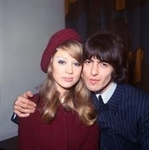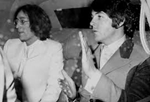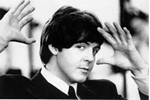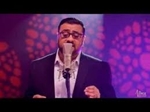- Register
- Log in to Tune-In
- Wishlist (0)
-
Shopping cart
(0)
You have no items in your shopping cart.
Beatles News

Three years ago, when the National Music Publishers’ Association presented Yoko Ono with their Centennial Song Award, Sean Lennon pushed his mother onto the stage at Cipriani 42nd Street in a wheelchair — shocking some who didn’t realize the formidable avant-garde artist was incapacitated.
But in her signature shades, black leather jacket and white Panama hat, the widow of John Lennon didn’t seem to miss a beat when she began a short acceptance speech by addressing the elephant in the room.
“Thank you, thank you, thank you,” she said, clutching the award in one hand and a microphone in the other as Sean whispered to her about what was going on. “I’ve learned so much from having this illness. I’m thankful I went through that.”
While it’s not clear what “illness” she was referring to, Ono, now 87, is still ailing, requires round-the-clock care and rarely leaves her sprawling apartment in The Dakota, a source close to her staff told The Post. In photos taken at rare public appearances — including a women’s march in Columbus Circle last year and at a commemoration of John in Liverpool in May 2018 — Ono is con details

Cher is one of the biggest icons to come out of the 1960s. Thanks to his time with the Beatles and his solo work, Ringo Starr is an icon of a similar caliber. Both are known for taking on more film roles than most famous singers and for having great senses of humor.
Despite this, people don’t associate Cher with Ringo. Perhaps they should. One of Cher’s first songs was about Ringo — and it became very controversial.
Cher first became a superstar as a member of the duo Sonny & Cher. She also has an incredibly successful and long-lasting career as a solo artist. Rolling Stone reports her solo career began when she released a song called “Ringo, I Love You” under the stage name Bonnie Jo Mason. Cher would later use the pseudonym Bonnie Jo Mason when she recorded vocals for the Wu-Tang Clan’s album Once Upon a Time in Shaolin.
Cher released “Ringo, I Love You” in 1964. According to AllMusic, Sonny & Cher released their debut album in 1965, which means that Cher was trying to be a solo artist before she found success as part of a duo. This is interesting, as some fans believe she began her solo career only after Sonny & Cher disbanded.
Source details

When Paul McCartney had George Harrison play guitar for John Lennon in 1958, George was 14 and looked even younger. Thinking back on those days before The Beatles existed, George noted how he small he was — and how he probably seemed to the 17-year-old John and his art school friends.
“I think he did feel a bit embarrassed about that because I was so tiny,” George told Crawdaddy Magazine in 1977. “I only looked about 10 years old.” But George could play guitar parts from the great Sun Records releases of the day. That was enough to get him into John and Paul’s band.
Two decades later, after the Beatles’ unparalleled success — both as a group and solo artists — John still thought of George as someone he’d helped make. “I think George still bears resentment toward me for being a daddy who left home,” John said in the 1980 Playboy interviews collected in All We Are Saying.
Source: cheatsheet.com
details
By the 1960s, musicians Eric Clapton and George Harrison had already become close friends, and they were so close that they ended up marrying the same woman.
Harrison, The Beatles lead guitarist, and his wife and model, Pattie Boyd, were married from January 21, 1966, until their divorce in 1977. Before their marriage ended, the pair separated in 1974.
When Clapton and Harrison became best friends, the former found himself infatuated with Boyd. For her part, she declined his advances but that didn’t stop him from loving her.
CLAPTON’S MARRIAGE TO BOYD
Clapton’s feelings for the model were so intense that he wrote songs about them. She inspired tracks like "Wonderful Tonight,” "Layla," and "Something."
Source:Junie Sihlangu/news.amomama.com
details
Sir Paul McCartney first found fame as the bassist and co-lead vocalist for the Beatles. Moreover, he has established his songwriting prowess largely as a part of the Lennon - McCartney. Together with fellow Beatle John Lennon, they both did music and lyrics, contrary to the usual partnership of a composer and a lyricist.Macca himself also wrote songs for others aside from The Beatles. Here are four songs, mostly written by Paul McCartney himself, for other artists:
"I'll Keep You Satisfied" (1963)
This hit single from Billy J. Kramer and The Dakotas is attributed to the Lennon-McCartney songwriting team. However, according to the Todd Compton book "Who Wrote the Beatle Songs? A History of Lennon-McCartney," Paul has written most of the track.
Source: Mark Alvin/musictimes.com
details
John Lennon and Paul McCartney wrote so many incredible Beatles songs. But did you know they made up one on the spot so they could go watch TV? According to Far Out Magazine, the singer-songwriters were working on The White Album when a movie they wanted to see came on.
In 1968 McCartney said: “What happened was The Girl Can’t Help It was on television.
“That’s an old rock film with Little Richard and Fats Domino and Eddie Cochran and a few others.
“We wanted to see it, so we started recording at five o’clock.
“And we said, ‘We’ll do something, We’ll make up a backing track.’”
Source: George Simpson/express.co.uk
details
It’s no secret that John Lennon and Paul McCartney were at odds in the years following the breakup of The Beatles. If you need some evidence, it’s easy to find, whether it’s John calling Paul’s first solo record “rubbish” or Paul dropping a few digs at John and Yoko Ono on his Ram (1971) album.
When working on his ’71 album Imagine, John used that energy to compose an epic response (diss track, if you like) to Paul titled “How Do You Sleep?” That’s the one in which he said Paul was making Muzak and only wrote one good song in his life (“Yesterday”).
Though Paul admitted to feeling anger in those days, he also spoke of how hurt he was by John’s message — a message seen and heard by the entire world. “I think he knew exactly what he was doing and because we had been so intimate he knew that would hurt me,” Paul said in his biography Many Years From Now (1997).
Source: cheatsheet.com
details
Swedish filmmaker Jonas Akerlund will direct a biographical drama film about The Beatles manager Brian Epstein.
Titled "Midas Man", the film will tell the story of the visionary music manager and impresario who was often referred to as the ''Fifth Beatle'', reported Deadline.
Epstein also worked with music artistes such as Gerry and the Pacemakers and Cilla Black, and helped promote musicians such as Jimi Hendrix, The Who, Cream and Pink Floyd.
But his tumultuous career was tragically cut short. He died of an accidental drug overdose at just 32.
The film''s producers, Trevor Beattie Films and StudioPOW, described the movie as "an emotional, witty, heartfelt story of the joy of success and the terrifying pressures of unspeakable risk and unfulfilled desire".
Source: Outlook/The News Scroll
details
By 1968, George Harrison was having a rough time being in The Beatles. Though he was writing songs such as “While My Guitar Gently Weeps” and “Long, Long, Long,” his bandmates still took some convincing to give his material any attention. That had begun to wear on George.
George didn’t have the same problem when he played with, say, Bob Dylan or his friend Eric Clapton. During a trip to America in late ’68, George jammed with both Dylan and Clapton, the latter of whom was playing in Cream at the time.
In fact, he and Clapton co-wrote a song just before that period that turned up on Goodbye (1969), the final album by Cream. And though you wouldn’t know it from the credits on the record, George also played rhythm guitar on the song he composed with Clapton.
Source: cheatsheet.com
details
The Beatles' Ringo Starr reveals he is set to REUNITE with bandmate Sir Paul McCartney during star-studded virtual concert to mark his 80th birthday
Ahead of the milestone day on Tuesday, the music icon confirmed Ringo’s Big Birthday Show, a charity show set to air on YouTube at 8pm
As well as Paul and Ringo, stars appearing at Big Birthday Show will include Sheryl Crow, Gary Clark, Jr., Sheila E, and Ben Harper
The show will also debut a version of Ringo's 2017 track Give More Love with Jeff Bridges, Jackson Browne, Elvis Costello, Willie Nelson among others
Source: Ciara Farmer/dailymail.co.uk
details
Here is a look at the life of musician Paul McCartney, former member of the Beatles.Birth date: June 18, 1942
Birth place: Liverpool, England
Birth name: James Paul McCartney
Father: James McCartney, salesman and musician
Mother: Mary (Mohin) McCartney, nurse and midwife
Marriages: Nancy Shevell (October 9, 2011-present); Heather Mills McCartney (June 11, 2002-March 17, 2008, divorced); Linda (Eastman) McCartney (March 12, 1969-April 17, 1998, her death)
Source: msn.com
details
Liam Gallagher, Dua Lipa and Sir Paul McCartney are among 1,500 artists who have signed an open letter calling for support for the UK's live music scene.
Ed Sheeran, the Rolling Stones and Coldplay also signed the letter to the culture secretary warning of the impact of Covid-19 on venues and musicians.
It says the music industry faces "mass insolvencies", with gigs and festivals unlikely to return until 2021.
The organisers said there had already been "hundreds of redundancies".
Job losses have been reported across venues, agencies and promoters, they said.
Source: Paul Glynn/bbc.com
details
An Indian American composer in Seattle, Washington, has won the top award in the World Music category in the 2020 John Lennon Songwriting Contest. The award, announced in May, is the first time an Indian song has won the award.
The winning song, "Akhiyaan," was written and composed by Indian American Rohit Batra of ‘Sur in Seattle’, produced by George Varghese of Verge Studios, and sung by “Indian Idol” alum Geetesh Iyer, according to a press release. "Akhiyaan" was also the Session 1 Grand Prize winner in 2019.
"This is a big moment for independent Indian musicians. We are breaking a mold as non-Bollywood music is being recognized on the world stage,” said Batra.
Source: indiawest.com
details
The Beatles breakup has to be the most discussed breakup in the entire music industry. Even after 50 years, fans still debate and argue about what caused the fab four to go their separate ways. But, that raises another question – what could have kept the Beatles together?
What would have kept the Beatles together?
Before diving into that, we first have to see what caused the Beatles to break up in the first place. We discussed that before, so if you want to jog your memory, give it a little read. So, here are the steps that could have prevented the Beatles breakup:
1. The Beatles should have been a professional band

Ringo Starr has announced a livestream benefit concert to mark his 80th birthday next week.
The star-studded event will consist of exclusive new at-home performances and previously unseen concert footage from former Beatles-bandmate Paul McCartney, Sheryl Crow, Joe Walsh, Ben Harper, Gary Clark Jr and more.
Donations during the event will be split between the Black Lives Matter Global Network, MusiCares, The David Lynch Foundation, and WaterAid. Ringo’s Big Birthday Show will air on the day of his birthday, July 7, from 5pm PST, on his YouTube channel.
Starr has long held concerts to mark his birthday in his adopted home of the United States. For the past 12 years, he’s hosted the ‘Peace and Love’ celebration event in Los Angeles on the date. Last year, David Lynch, Peter Jackson, Nils Lofgren, Sheila E., Benmont Tench, Ed Begley, Jr. and more joined him.
Source: nme.com
details